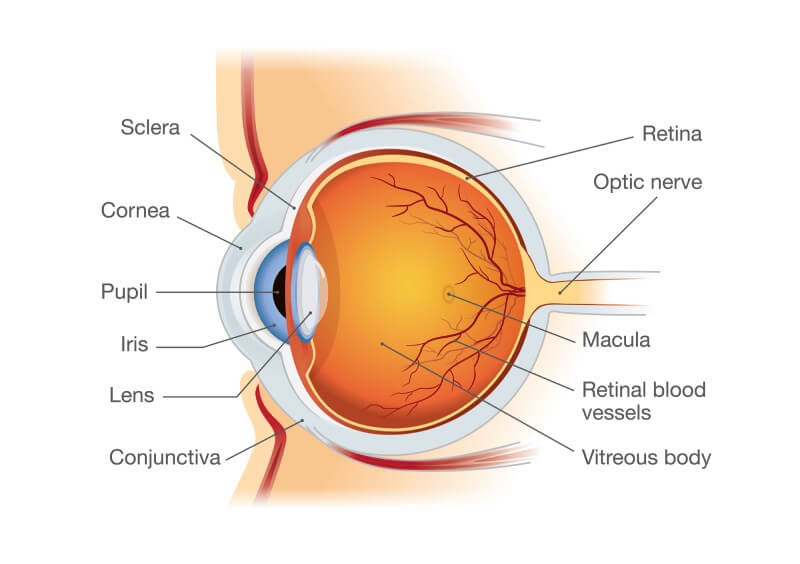Eyeglasses for Astigmatism 101: A Clearer Perspective

If your vision isn’t crisp, you are not alone. Millions of people in Canada and around the world have vision conditions that make them experience the world in a blurry way. Astigmatism, for example, can make it difficult to focus while reading and doing many other daily activities such as driving at night.
Below we’ll discuss astigmatism in-depth from the definition to the levels, treatment during eye exams, getting glasses, and more!
What is Astigmatism?
Astigmatism is an eye condition characterised by an irregularly shaped cornea or lens.¹ The normal eye has an even round shape. With astigmatism, the eye assumes an oval or irregular shape.

What Does Astigmatism Do?
Normally, a well-rounded cornea and lens make the eye focus light rays perfectly onto the retina ensuring you see clearly. An irregularly shaped cornea and lens can make both near and far vision blurry. There’s more on what astigmatism does to your vision below.
Levels of Astigmatism
There are three main levels of astigmatism based on severity. They include²:
- Mild astigmatism: this level has less than 1.00 diopter (a unit of measurement representing optical strength/power). A perfectly shaped eye (rounded) measures 0 diopters. While most people won’t have a perfectly rounded eye, their level of astigmatism is usually very mild and doesn’t cause any noticeable vision issues.
- Moderate astigmatism: This is astigmatism ranging between 1.00 and 2.00 diopters. If you have moderate astigmatism, you’ll experience common symptoms mentioned above i.e., headaches, eyestrain, and blurry vision at any distance.
- Severe astigmatism: This is the strongest form (above 2.00 diopters). People with severe astigmatism experience serious vision symptoms including extremely poor vision over any distance.
What Level of Astigmatism Requires Glasses?
A moderate level of astigmatism will mean you need help correcting your vision. If you have a measurement of 1 diopters or above, you need contact lenses or eyeglasses to enjoy clear vision.

How To Know If You Need Glasses for Astigmatism?
Individuals with moderate astigmatism (a measurement of 1+ diopters) or more need glasses. If you fall within this category, you’re bound to experience the following symptoms of astigmatism and this will be a confirmation that you need glasses³:
- Blurred vision or distorted vision
- Eye strain
- Headaches
- Squinting
- Eye discomfort
- Poor night vision
Important: While the above symptoms highly suggest you have astigmatism and may need glasses, it’s worth noting that the symptoms are also prevalent with other common vision conditions like myopia (near-sightedness) or hyperopia (farsightedness) which are other visual refractive errors.
As a result, you should book a comprehensive eye exam from a seasoned Optometrist to confirm if you need glasses for astigmatism.
Schedule an eye exam with Kodak Lens – leading Canadian-based Optometrists that offer eye exams, dispense eyeglasses, contact lenses, and offer other eye care and optical services.
Can Eyeglasses Correct Astigmatism?
Yes! Eyeglasses can correct astigmatism. However, glasses with just spherical lenses won’t help because the uniform curvature throughout will only help with far or near-sightedness, but not astigmatism. What you need are glasses with special toric or cylindrical lenses to refocus light on your retina and help you see more clearly. The amount of astigmatism you need is shown in the “Cyl” section of your eyeglasses prescription. Speak to an optician or optometrist to learn more about your prescription.

What Types of Eyewear for Astigmatism Are There?
There are two main types of lenses used in astigmatism glasses and/or contacts for persons with astigmatism⁴:
1. Toric Soft Contact Lenses
Toric or spherocylindrical contact lenses combine features of different lenses i.e. those of cylindrical and spherical lenses (used for farsightedness and near-sightedness). Toric lenses have curvature in different directions.
This combination makes them effective in astigmatism correction and correcting other refractive errors such as farsightedness and near-sightedness. Toric contact lenses are ideal for persons with mild to high astigmatism that love to be active through sports or the freedom of not needing eyeglasses.
2. Cylindrical Ophthalmic Lenses (Spherocylindrical Lenses)
Cylindrical ophthalmic lenses (spherocylindrical lenses) are used for correcting astigmatism where parallel rays aren’t focused perfectly (uniformly) in all meridians⁵. This additional feature in ophthalmic lenses is important to correct astigmatism. Your eye care professional will recommend these special optical lenses in order for you to correct and treat your astigmatism. To be able to see well, your eyeglasses must be made according to your prescription from the optometrist.
Other Types of Lenses We Carry at Kodak Lens Vision Centres
Besides spherical and toric lenses, we also offer multifocal (progressive lenses) featuring focal ranges for far, intermediate and near distances. Ask us about our Kodak Unique and Precise progressive lenses. We also have bifocal and trifocal lenses that can also help with astigmatism.
Astigmatism Prescription: Does Astigmatism Change Your Glasses Prescription?
Yes! Astigmatism can change your glasses prescription over time since the condition relates to the shape of the cornea which can change with age⁶. Other causes of corneal changes (although temporary) include hormonal changes experienced during pregnancy⁷. Some eye conditions i.e., Keratoconus can also change the shape of your corneal prompting a change in prescription glasses⁸.
Can Astigmatism Be Cured?
Eyeglasses or contact lenses can correct most, if not all astigmatism cases. However, other options like refractive surgeries i.e., laser surgery treatments like LASIK can be explored if you don’t want to wear a pair of glasses or contacts⁹. You can book a LASIK consultation for astigmatism at Kodak Lens Vision Centre to know if this is a viable option for your particular case.
Can Astigmatism Get Worse? What Causes Astigmatism to Get Worse?
Yes. Astigmatism can improve or worsen over time. Astigmatism worsens mainly due to aging and the resulting ocular changes. The condition can also worsen if you don’t seek treatment¹⁰. Other reasons behind the worsening include eye injuries.
Final Thoughts
Astigmatism is a fairly common ocular condition that affects millions in Canada and around the world. If you suspect you have astigmatism, don’t worry. There are eyeglasses and contact lenses for correcting this visual condition.
If you live in Toronto or the Greater Toronto Area, book a comprehensive eye exam at Kodak Lens Vision Centre to enjoy highly personalised eye care services from some of the most experienced and trusted Optometrists in Canada. This is the first step to understanding your visual needs and eye health.
Call 647-952-1099 to get eyeglasses for astigmatism with greater visual comfort attributable to superior KODAK Lens technologies (i.e., i-Sync, Variable Geometry, Digital Freeform, Adaptive RX & Vision First). Kodak Lens also offers a wide selection of frame designs that best fits your style and comfort. Kodak Lens eye care professionals will always provide the optical care, guidance, recommendations and lens design customizations based on wear for optimal viewing experiences. Let us help you See The Colours of Life.
References
- 2023, What is Astigmatism? AAO.org:
- 2021, What Astigmatism Measurements Mean. AAO.org:
- 2021, Astigmatism. MayoClinic.org:
- 2023, What is Astigmatism? AAO.org
- 2024, Concave, Convex & Cylinder Lenses, AAO.org:
- 2020, Changes in Corneal Parameters With Age, Sciencedirect.com:
- 2019, Ocular Changes During Pregnancy, National Library of Medicine, ncbi.nlm.nih.gov:
- 2023, Keratoconus, Mayoclinic.org:
- 2021, Astigmatism. MayoClinic.org:
- 2022, Astigmatism: Symptoms, Tests and Treatment, clevelandclinic.org:
